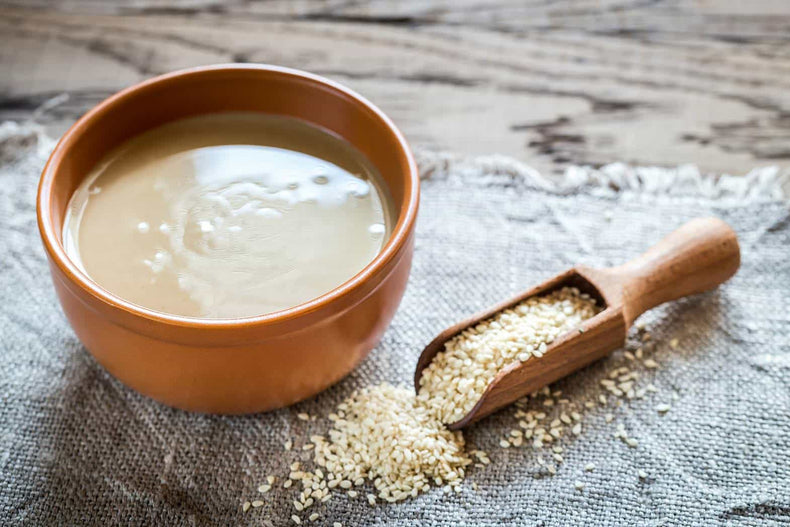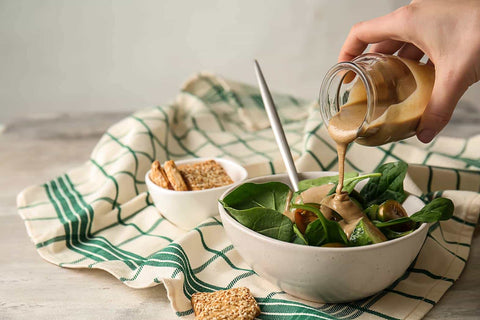Everything you need to know about Tahini
by Holly Thomson

Tahini is a rich, smooth paste and a staple of Middle Eastern, Mediterranean and Levantine cooking. It is perhaps best known as the crucial secondary ingredient in hummus after chickpeas. Tahini is also traditionally made into a creamy dressing for roast veg and falafel, or used in sweet recipes such as crumbly, fudgey halva. Read on for the best ways to use tahini and choose the creamy Middle Eastern paste that’s best for your cooking.
What is tahini?
Tahini is a smooth sesame seed paste and staple of Middle Eastern cooking. Tahini comes from the Arabic word ṭaḥīniyya which translates as ‘to grind’, and describes the way sesame seeds are ground to create this paste.
One of the most popular uses of tahini is for making hummus, however tahini can also be used as a dressing for falafels, or in sweet recipes such as babka, cookies and blondies.
What is tahini made of?
Most commercial tahini is made from ground sesame seeds that have had their shells removed. This creates a pale colour and very smooth texture. If you make tahini a home you can use seeds with the shells still on. It will create a coarser texture, and a deeper golden yellow colour. You can even make tahini from black sesame seeds, for a dramatically dark dressing!
What does tahini taste like?
Tahini has a deep nutty flavour, which works in both sweet and savoury recipes – just like peanuts. Good tahini is rich and oily, while some inferior brands will have a note of bitterness or a chalky feel in the mouth. If tahini has stood in a jar for a long time the oil can naturally rise to the top and separate. If this has happened, make sure to stir it well before using – to get the best consistent and full-bodied flavour from your tahini.
How to make tahini
Tahini is simply made with blitzed sesame seeds. Do this in a food blender or processor.
You may need to add a dash of oil while you whizz the seeds in a food processor, to help loosen the mix. But there should be enough natural oil in the seeds to create the familiar thick, creamy paste.
Gently toasting the seeds beforehand will also help release some of this oil.
How to make a simple tahini dressing
- To make a classic Israeli dressing – also known as tahini sauce – whisk the sesame paste with ice cold water
- Add lemon juice, garlic and a pinch of salt until lightly coloured and silky smooth.
- Spoon generously over falafel, grilled fish and almost any roasted vegetables.

How do you use tahini?
Savoury tahini ideas
Creamy tahini is fantastic in dips, dressings and sauces. Use it to make the popular Lebanese dish samke harra, from Tripoli. The dish is a whole lemon marinated fish, topped with a spicy tahini sauce.
Or try coating a whole cauliflower head with tahini and ras al hanout and roasting in the oven until soft and nutty.
Make a simple tahini dressing as above, or stir it through yoghurt with a squeeze of lemon and finish with a sprinkling of pul biber.
Or mix a couple of tablespoons of tahini into smoky aubergine baba ganoush for an even deeper flavour.
Add a few tablespoons of tahini to homemade coleslaw, with peanuts and spring onions for an Asian twist on the classic salad.
Sweet tahini ideas
- For something sweet, try making tahini ice cream or stir a spoonful into a simple cookie mix to make crumbly biscuits
- Dark chocolate tahini brownies create the perfect mix of sweet, nutty, rich flavours – swirl a dollop of tahini into raw brownie mix before it goes into the oven.
Exciting Recipes Using Tahini
Addictive Sichuan chilli pork noodles, loosened with tahini or Asian sesame paste. An orchestra of flavour!
Maftoul Salad

Giant couscous, tumbled with roast carrots, feta, date and fresh mint leaves. Dressed with tahini and lemon.
Baby Gem Lettuce with Burnt Aubergine Yoghurt

Dressed with smacked cucumber and spicy shatta chilli paste, this baby gem lettuce makes a great stand-alone starter or serve it as a side to roast lamb.
Black Tahini and Honey Babka

Use black tahini for dramatic swirls in this sweet braided bread, rich with cocoa.
Sami Tamimi and Tara Wigley's Sweet Tahini Rolls

Simple to make yet impressive to look at, these tahini rolls are best eaten as they are, or sliced and spread with tahini and date molasses.
Which tahini should I buy?
This brand of tahini is one of the best we've tried at Sous Chef. It has a velvety texture, with a slightly sweet and wonderfully nutty flavour. To make a classic Israeli dressing - also known as tahini sauce - whisk the sesame paste with ice cold water, lemon juice and a pinch of salt until lightly coloured and silky smooth.
Lebanese SH Yaman tahini, or tahineh, is a smooth, creamy sesame paste that’s indispensable in Lebanese and other Middle Eastern cuisines. Use to make a popular Lebanese dish from Tripoli called samke harra, or ‘spiced fish’. It’s a dish of baked, lemon marinated white fish that’s topped with a spiced tahini sauce.
Belazu tahini is made using seeds from Ethiopia, which are skillfully roasted to release a rich, nutty flavour. The seeds are then double-ground to create Belazu tahini’s signature creamy texture and glossy finish.
With a smooth texture and nutty flavour, this tahini is wonderful in both sweet and savoury cooking. Mix the sesame paste with water, lemon juice and a little salt to create a classic Israeli dressing. Alternatively, pair with dark chocolate in cookies and babka bread.
Frequently Asked Questions
How do I store tahini?
Tahini is an ambient product that doesn’t need to be refrigerated. Store it away from direct sunlight, and away from heat sources.
What is tahini made of?
Tahini is made with 100% ground sesame seeds. This is what gives the paste an intense nutty, slightly sweet flavour and glossy texture. Black tahini is made with black sesame seeds which is why this version has a striking colour.
Is tahini like peanut butter?
Peanut butter and tahini are similar in that they are both made of ground nuts and seeds, however, many peanut butters have oil and salt added to them. Tahini and peanut butter are both pastes that can be used in sweet and savoury dishes to provide a nutty flavour. Tahini has a slightly sweeter flavour and looser texture compared to peanut butter.
If it’s a nutty flavour you’re after in sweet recipes, peanut butter would work as an alternative (however it will be stronger in taste than tahini), however in classic Middle Eastern dishes such as hummus and dressings, peanut butter would not work.
What is a substitute for tahini?
Tahini is unique in that it’s made from 100% sesame seeds - unless you make your own, you won’t find a substitute that tastes exactly the same. If it’s the texture of tahini you want to replicate, a smooth, neutral flavoured nut butter such as cashew or almond works well.
Find more Middle Eastern recipes here, or take a look at all the Middle Eastern ingredients available at Sous Chef here.







